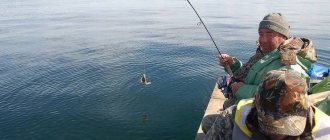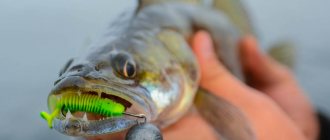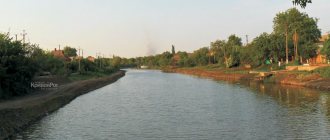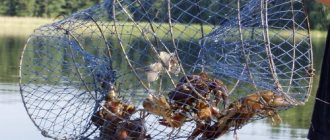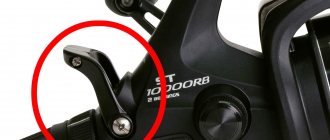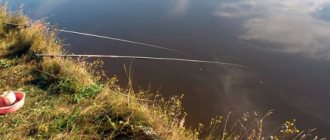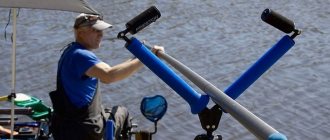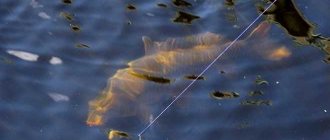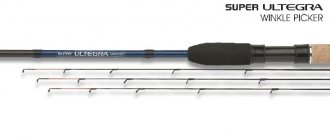Setting up a fishing lane
A net with an elastic band is designed on the principle of a donkey with a rubber shock absorber, only here, instead of a dozen hooks, there is a net.
It is structured as follows:
- a pole for securing the gear on the shore (a regular stick can be used instead);
- fishing line connecting the mesh and the pole;
- network (up to 7 m);
- the top edge is equipped with a floating cord;
- the lower edge is threaded with weights (weight cord);
- cargo (stone or brick);
- rubber thread (connects the upper edge of the mesh and the load).
Sometimes a signal bell is tied to the fishing line, notifying the fisherman about a bite. The use of a bell is justified when it comes to catching large fish.
If a large perch gets caught in the net, it will roll up its web with its power and no one else will get caught there. With the use of a bell, a fisherman in such a situation will be able to remove the catch and cast the tackle again.
Throwing a net goes like this:
- A fisherman throws a load into the river.
- The load pulls along a net with a float and cargo line.
- The fishing line and shock absorber, fastened with carabiners, are separated and attached to loops located at the ends of the float cord.
- The weight of the carabiners is offset by two foam floats, which, in addition, help the net keep its rectangular shape.
The height of the device reaches one and a half meters, length – 7 m.
Fishing net with elastic band
A fishing net or fishing line is a favorite tackle of many experienced fishermen; it is a mixture of a slingshot and a net, used both for catching large fish (perch, pike, etc.) and for catching live bait (bait for predators). It is more correct to call it a “mesh with a rubber shock absorber” or a “screen with a rubber shock absorber”, depending on the size.
A group of fishermen revealed the name of the secret bait during interrogation.
Category: regional news.
- Setting up a fishing lane
- Features of operation
- Application area
Setting up a fishing lane
A net with an elastic band is designed on the principle of a donkey with a rubber shock absorber, only here, instead of a dozen hooks, there is a net.
Features of operation
Fishing with a fishing line requires knowledge of the body of water and its inhabitants.
Fishing with such nets using complementary foods, for example, a mixture will be especially successful:
- silt;
- sand;
- clay;
- pearl barley;
- cake;
- garlic, etc.
Then, even in the absence of a float bite, you will get several small trophies.
Throw it in after clearing the bottom.
It is necessary to correctly calculate the weight of the load so as not to accidentally tear the rubber when removing the catch.
Application area
A fishing net with a rubber shock absorber is used in small bodies of water, mainly in urban ponds, where there are quite a lot of fishermen in a small volume of water space:
- This compact, easy-to-use and portable gear is perfect for relaxing after work for two or three hours.
- Its use is especially important during the heyday of water lilies, when it is impossible to set up large nets, but casting fishing lanes makes it possible to increase the catch of pike, which hide in water lilies from the heat.
The main rule is that the reservoir should be deep and, if possible, with a clean bottom.
Fishing with an elastic band - features of making tackle, fishing techniques and tactics (85 photos)
For hundreds of years, this original Russian invention has been helping people get good catches. Specimens, sometimes reaching 20 kg, cannot but delight the fisherman. Today we will talk about elastic. A bottom fishing rod with a rubber shock absorber is its official name. This fairly simple fishing method works incredibly clearly and smoothly.
Fishing with a rubber band is an amazing method that can cover all types of rivers and reservoirs that are of interest to each individual fisherman.
Brief contents of the review:
What does the track tackle consist of?
There are no standards for network tracks, however, the most common composition you can see is:
- Spinning reel
- Carbon fiber spinning rod
- Network
Fishing tackle-track can have different interpretations. For example, instead of a spinning reel, a multiplier reel is quite suitable, and a high-quality “braid” can be replaced by 0.3 mm monofilament.
Pros and cons of using braided cord and monofilament. You should start with the fact that they differ in size: if the monofilament has 0.3 mm, then the section of the braided cord varies from 0.17 mm to 0.2 mm.
In general, the main difference lies in sensitivity: the bell when using “braid” rings even when it slightly touches the bottom, while monofilament is less sensitive to this fact. It all depends on what kind of fish you came to the pond for.
It is also worth noting that monofilament is less tangled than braided line - it can provide a greater catch. Another fishing tackle is made using a similar principle - a track with a rubber shock absorber, therefore the principle of fishing where a mesh track is used is similar. One of the differences is that donks with a rubber shock absorber use five to ten hooks instead of nets.
How to prepare for fishing
For successful fishing we will need:
Fishing line. It's better to take a thicker one. But in no case less than 0.3 mm. So that at the moment of hooking it suddenly does not break off.
Hooks. From 4 to 7 pieces size 6.
Small weight. It is better to take a weight with an eye for attaching a fishing line. With the weight of the weight, everything is individual. In some cases this is several tens of grams or several kilograms.
Instead of a sinker, you can use a feeder, which will additionally attract fish to the fishing spot.
Rubber. Previously, aircraft model rubber was actively used; now in fishing stores you can purchase this rubber of absolutely any diameter.
Guard (bite alarm). In this process, installing a bite alarm will be very important. It will notify you that the fish has swallowed the hook.
In this case, it is necessary to act as quickly as possible. You can find it where you are going to fish, or purchase it in advance at a fishing store. As a rule, these are electronic alarms.
Next, we remove the catch, replace the bait and lower the elastic band again. There is no need to take out the weight. The whole process is quite silent, which is undoubtedly important for any fishing.
Network Installation Tips
Depending on where exactly you place the net, your catch depends. For example, if the bottom is not viscous, then you can put a path near the shore - for this you don’t even need to swim somewhere. This is a very good way to set up a net during the active hunting season for predators.
Using boats gives you more room to maneuver. A good catch will be ensured by a net placed in places where the depth of the bottom changes sharply - a kind of cliff, only under water. In such places, pike perch and perch are often caught in the net.
After each fishing trip, the net, like any tool, must be carefully inspected for holes, timely repairs made as necessary, and cleaned of algae and other debris. The positive aspects of elastic compared to other bottom fishing rods:
- In case you are catching a large fish, it is unlikely that the line will break, since the elastic band is shock-absorbing;
- High sensitivity;
- You can catch any fish with this type of bottom fishing rod;
- The process of re-planting bait is greatly facilitated due to the fact that the hooks do not lie on the ground, but hang on a fishing line;
- The sinker does not cling to any obstacles such as stones and grass, which makes landing fish more convenient.
How to throw
We recommend that when fishing with a rubber band on rivers, choose places with little water flow, or no current at all.
First, the tackle is scattered on the shore of the reservoir, in order to avoid further confusion of fishing lines and other things, as well as away from stones and vegetation.
The reel is secured to a peg driven into the ground. Various kinds of bait are strung on hooks. The fishing line is made in the same way as for a simple donkey. You need to bleed it carefully into a reservoir, a little upstream.
The sinker is thrown by the angler in a circular motion as far as possible. After casting the line, you usually wait 5 minutes so that the weight can better “stick” to the bottom of the river.
After this, the fishing line must be carefully pulled ashore. In this case, you need to feel that the elastic band is stretched thanks to the weight that lies at the bottom. The bait and tackle are attached to hooks, and the angler pulls the line into the water.
What kind of fish is suitable for line fishing?
In principle, in this way you can catch any fish, including large ones, if you choose the right bait that will be interesting to the species you came for. However, this does not always mean that only pike or perch will be caught in the net.
Line fishing is also suitable for those who do not want to sit tensely with a fishing rod - this type of fishing will not force you to sit for hours in one place in a tense position. You will be able to “open the season” by simultaneously preparing barbecue. The most favorable periods for fishing are from the second half of July until the end of autumn, with the peak being in August-September.
Fisherman, remember!
Considering that summer is approaching, but the winds are still blowing through reservoirs, it is worth remembering the water safety rules. The boat should always have a life jacket or any other device that can help you stay above the water in case of danger.
It would also be a good idea to leave a first aid bag in the boat, the contents of which you will select individually. Among the essentials there should be ammonia, alcohol and cotton wool.
Catching pike on the path
Pike spawns during the spring opening of rivers. Soon after it, a quiet prey hunt begins, which can continue until late autumn. Many fans believe that the best way to catch pike is on a track. The fish are caught on the track from a boat moving across a pond. The boat should be light and maneuverable. One person sits on the oars, the second treasures. But you can do it alone with a certain skill.
Fishing places
When planning a hunting strategy, the angler will need to know the places where there is a high probability that a predator will show interest in the movement of the bait. Pike loves quiet and shallow backwaters, located on the borders of thickets and free areas of water. Pike perch are caught on the currents by guiding the boat over underwater holes and ditches, trying to move with each subsequent pass closer to the ledges that turn into shallower water areas. Catfish are searched for at the boundaries of calm water and deep pools, as well as at the junctions of clear water zones with snags and dead wood. The perch stays near the cliffs of the banks, where the currents slow down and turn into a slow reverse thrust. The fishing spots for the asp are determined by its fight, trying to guide the boat exactly along the trajectories of its hunt, and these are rifts and exits to the sandbank with a calmer and even current.
Methods of fishing on the track
The track is a special device for catching predatory fish, which has several varieties.
- Catching by hand. The fisherman holds a loose line in his hand, and some even manage to hold it in their teeth, which is convenient when fishing alone. You can also press the cord with your foot or paddle.
- Fishing with a special reel.
- Fishing with a rod equipped with a reel. This is the best and more convenient equipment for the track, allowing you to maneuver a moving spoon and bring out fish stuck at depth.
Feeders
You can study the video of rubber band fishing.
It will clearly show how to assemble this structure, as well as get the largest possible catch.
Equipment for fishing on the track
Any rod equipped with guide rings is suitable for making a track: a reed rod with a thickened butt, 1 to 1.5 m long; rods for spinning fishing; from bamboo, hazel, young birch and other elastic wood. Usually the length of such a rod for the track is arbitrary, most often about 3 m. But longer ones can be used for fishing in thickets of bushes or reeds, when it is necessary to maneuver a moving spoon, circling it from one side or the other between the branches and shifting the rod from hand to hand .
Any reel for the track is suitable, has good strength and can accommodate 100 m of cord.
For equipping a track on a fishing rod, “Saturn” (0.35-0.5 m), also “Kapron” and cord No. 1 are well suited, and for a track for fishing “by hand” or with a reel - cord No. 2. The length of the cord is approx. 100 meters.
A leash for this purpose is required with two carabiners at the ends, solid, steel, 1 to 1.5 meters long.
To avoid twisting of the cord when the spinner rotates while moving, a weight is attached between the cord and the leash, the weight of which is determined practically, usually from 20 to 45 g. When fishing with a heavy spoon, the weight is replaced with an anti-kinker.
When catching pike on the track, all kinds of spoons are used as bait. In spring - larger, in summer smaller. Larger again in the fall.
The color of the spoon and its shape is determined experimentally and depends on the conditions in which the pike lives. You can also value live bait. It is better to take spinners from thin metal; they are more mobile and “playful” when retrieved than heavy ones. Heavy lures can also be used under certain fishing conditions.
Track fishing technique
The technique of catching pike on the track is quite simple, but it requires practical knowledge and skills in using tackle and operating a boat.
Fishing alone starts from a shallow, clean place, lowering the spoon to the bottom. They secure the rod in the boat or clamp it between their knees, gradually releasing the cord, and quietly move away from the shore. Having driven to the required distance, take the rod in your hand, lifting the spoon from the bottom with a slight sharp movement, and direct the boat upstream, adhering to the chosen course.
If you are going to use the spinning method, you can start right away, not from the shore. You need to row quietly, without making unnecessary splashes and noise, while the boat should move evenly, without jerking, then the spoon will remain at the same depth all the time, without rising or sinking unnecessarily. Based on fishing conditions, the length of the cord is adjustable from 20 to 80 meters. The shallower the location, the longer the length of the cord. If the fishing depth is 1.5-2 m, then the optimal cord length is from 40 to 60 m.
The spoon should not go along the bottom, but also not rise high. About half a meter from the bottom will be enough if it is relatively flat and clean. If the bottom of the reservoir is uneven, then it is better to cast the spoon at a distance of 1 meter from it or at “half water”. When the boat moves slowly, the spinner dives deeper, and when the boat moves faster, it rises higher. Therefore, in a fast current you need to row more slowly, and in a slow current - a little faster. The required speed is determined on site in a practical way.
You can check whether the spoon has caught water grass or debris from the bottom by listening to the movements of the cord. If it vibrates evenly in your hand, it means the spoon is free and moving correctly. If it is clogged, you will not feel vibrations.
To clear the lure of debris clinging to it, jerk the cord sharply several times. But sometimes this technique does not help, then you need to pull out the track, clean it of debris and unravel it again.
